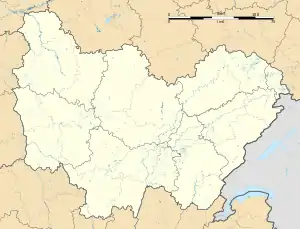Marcigny | |
|---|---|
 A general view of Marcigny | |
 Coat of arms | |
Location of Marcigny | |
 Marcigny  Marcigny | |
| Coordinates: 46°16′32″N 4°02′32″E / 46.2756°N 4.0422°E | |
| Country | France |
| Region | Bourgogne-Franche-Comté |
| Department | Saône-et-Loire |
| Arrondissement | Charolles |
| Canton | Paray-le-Monial |
| Government | |
| • Mayor (2020–2026) | Carole Chenuet Gaillard[1] |
| Area 1 | 8.15 km2 (3.15 sq mi) |
| Population | 1,720 |
| • Density | 210/km2 (550/sq mi) |
| Time zone | UTC+01:00 (CET) |
| • Summer (DST) | UTC+02:00 (CEST) |
| INSEE/Postal code | 71275 /71110 |
| Elevation | 237–338 m (778–1,109 ft) (avg. 242 m or 794 ft) |
| 1 French Land Register data, which excludes lakes, ponds, glaciers > 1 km2 (0.386 sq mi or 247 acres) and river estuaries. | |
Marcigny (French pronunciation: [maʁsiɲi]) is a commune in the Saône-et-Loire department in the region of Bourgogne-Franche-Comté in eastern France.
History
Marcigny was the site of the first Cluniac nunnery, founded in 1056. St Anselm was unsuccessful in attempting to enroll his sister Richeza there after the death of her husband amid the First Crusade. Adela of Normandy, Countess of Blois, mother of King Stephen of England, died in a convent here in 1137.
Economy
The major manufacturer of the city is Emile Henry (ceramic).
See also
References
- ↑ "Répertoire national des élus: les maires". data.gouv.fr, Plateforme ouverte des données publiques françaises (in French). 2 December 2020.
- ↑ "Populations légales 2021". The National Institute of Statistics and Economic Studies. 28 December 2023.
Wikimedia Commons has media related to Marcigny.
This article is issued from Wikipedia. The text is licensed under Creative Commons - Attribution - Sharealike. Additional terms may apply for the media files.